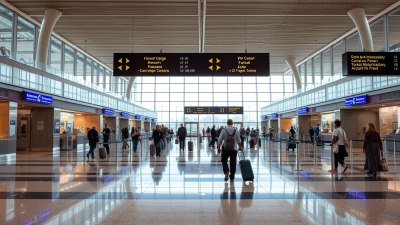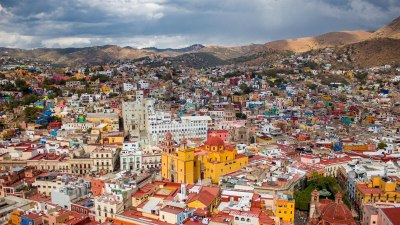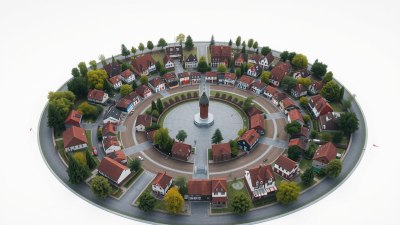Airports Are Rituals Dressed as Infrastructure
Explore how airports merge rituals with travel infrastructure, shaping our journeys.

Image created with Flux Schnell
Airports represent a unique intersection of functionality and ritual that shapes contemporary travel. As gateways to the world, they embody not only the physical means for transit but also a plethora of cultural practices and emotional experiences that travelers engage in. While most people view airports simply as places to catch flights, these bustling hubs serve as significant landmarks in our lives, loaded with rituals that transcend the logistical framework of air travel.
The moment one steps into an airport, the atmosphere changes. There's an electric energy, a heightened sense of anticipation. For many, airports mark the beginning of significant journeys—whether that involves a family vacation, a business meeting, or a journey home. This underlying sense of purpose, combined with the architecture and design of the terminal, creates an environment where every action, from check-in to boarding, takes on a ritualistic aspect.
The Architecture of Ritual
Airports are designed to facilitate efficient movement through space, yet the layout also encourages behaviors akin to ritualistic practices. The organized chaos of arrivals and departures, the extensive signage, and the queueing systems are all meticulously designed. The transition from ground to air is anything but random; it's a series of deliberate steps that have been crafted over decades. As travelers navigate through security checks, they engage in a performance marked by ritualistic gestures: removing shoes, placing bags on conveyor belts, and stepping through scanners. These actions, while practical, also serve to bring about a sense of belonging to an exclusive group of travelers.
Many airports are adorned with art installations, reflective of local culture and history. From stunning murals to sculptures, these artistic elements create a narrative that resonates with the cultural identity of the region. Airports like the Denver International Airport, famous for its towering blue horse statue, engage travelers in a visual experience that transcends mere functionality. This blending of art and architecture invites exploration and introspection, transforming routine transit into an enriched experience.
Rituals of Departure and Arrival
The act of departing from or arriving at an airport carries substantial emotional weight. Departure rituals may include tearful goodbyes or joyful send-offs, both acting as poignant markers of transition. These moments are steeped in personal significance; they highlight the emotional labor and societal expectations surrounding travel. Similarly, the arrival ritual often involves reunion, the joy of reconnecting with loved ones, or the thrill of exploration. Beyond the physical transport, these experiences within the airport framework echo a deeper, universal human experience of connection and separation.
Travelers might also observe customary practices—checking in their luggage, hurrying to their gate, or stopping for a bite to eat before a flight. These activities are imbued with rituals that bring comfort amidst the chaos. Terminal food courts have become spaces for people to bond, either with strangers or among friends and family. The act of sharing a meal evokes a sense of normalcy and ritual in a transient environment, reinforcing the importance of human connection even in a sea of strangers.
The Role of Technology
Advancements in technology have impacted the way these rituals manifest. The shift towards digital boarding passes and online check-ins may seem to simplify the travel process, but it also alters the character of the airport experience. While it removes some of the traditional rituals associated with air travel, such as standing in long lines, it introduces new elements like the anxiety of mobile connectivity. Is my boarding pass downloaded? Is my wallet on my phone? This technological shift has created a new set of rituals that accompany the travel process.
Personal devices have evolved into essential traveling companions, altering how interactions occur in the airport setting. Many have their earbuds in, cocooned in their own worlds, yet simultaneously, this technology amplifies the possibility for connection through social media. Airports have developed digital platforms to connect passengers, offer live updates on flight status, and more. Electronic screens flicker with information, reflecting the urgency that characterizes these spaces, creating a dual sense of immediacy and connection.
Cultural Differences in Airport Rituals
Different regions and cultures exhibit unique airport rituals, reflecting local traditions and customs. Airports in Japan embody meticulous politeness, while those in the Middle East may manifest elaborate customs that reflect bedouin hospitality. Observing how these cultural narratives unfold in airports can offer insights into the societies they serve. These distinctions paint airports not merely as transit points, but as vivid representations of cultural identity, intertwining the sacred and profane in our travel patterns.
Passengers often partake in local cuisine as part of their airport experience; this journey through gastronomy before a flight is a ritual in itself. Tasting local flavors or grabbing a quick Starbucks, passengers take pieces of their travel destination with them or hold onto remnants of home. The airport transforms into a liminal space—a threshold not just geographically but culturally, where travelers simultaneously depart from their homes and enter new worlds.
Psychological Aspects of Airports
The psychological territories of airports are equally intricate. For some, they symbolize freedom, adventure, and exploration; for others, they can elicit stress, anxiety, or a sense of dislocation. As people traverse through bustling terminals, each individual carries their own emotional baggage, compounding the existing rituals. Research indicates that the stress of travel can significantly affect mood, creating an emotional landscape rife with tension.
Interestingly, many airports have begun to address this through designs that emphasize tranquility. Features such as calming art installations, comfortable seating areas, and even yoga rooms are becoming more prevalent. These elements serve not only to distract from the stressors of travel but also to cultivate rituals of relaxation, enabling travelers to recharge before the next leg of their journey. By acknowledging the mental load of travel, airports are evolving and becoming spaces that facilitate emotional well-being.
Airports in the Age of Globalization
In our increasingly interconnected world, the role of airports as rituals is magnified. The easing of borders facilitates the flow of people and ideas, embedding airports deeper into the global tapestry of cultural exchange. As individuals journey across borders, they bring their customs, lifestyle choices, and belief systems, turning airports into microcosms of global society. This phenomenon generates new rituals formed through the blending of diverse cultural practices.
A single airport terminal may contain travelers from myriad backgrounds, each carrying their individual narratives, traditions, and rituals. It is here where the complexities of human interaction become most apparent. Travelers bond over shared experiences, exchange cultural practices, and perhaps adopt or adapt new rituals along the way. This communal aspect of airports reminds us that we are all part of a larger, interconnected world—where individual journeys converge and diverge.
Future Perspectives on Airport Rituals
The future of airports as sites of ritual will likely continue to evolve alongside technological advancements and changing societal norms. As air travel becomes more democratized, we may see a greater infusion of diverse cultural practices into airport experiences. Innovations in the design and structure of airports will also redefine these spaces, blending physical and digital realms, creating novel environments that remain adaptable and meaningful.
Moreover, as sustainability becomes an increasing concern for travelers, the incorporation of eco-friendly practices and materials into airports may also introduce new environmental rituals around travel. Airports might evolve into spaces that not only address passenger comfort but also act as advocates for the planet, showcasing local flora, promoting sustainable products, or integrating communal spaces dedicated to education and awareness.
In conclusion, airports are not just transit hubs; they embody the intersection of ritual and infrastructure that shapes our travel experiences. They are complex entities, rich with diverse cultural narratives that offer opportunities for connection, reflection, and engagement. By recognizing the ritualistic aspects of airports, we can gain deeper insights into the nature of our journeys, allowing us to appreciate the collective human experience that transcends geographical boundaries. As airports continue to evolve, they will undoubtedly retain their significance as valuable spaces that honor both the journeys we take and the emotional systems we navigate along the way.











